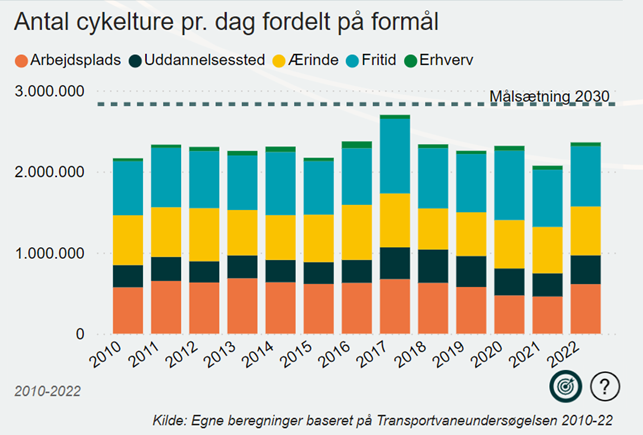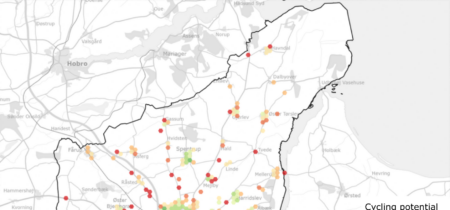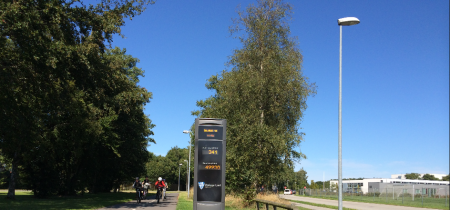The National Bicycle Account collects data on cycling
The National Bicycle Account is an interactive tool that collects and visualizes data on cycling in Denmark from a wide range of data sources. Thus, the Bicycle Account democratizes bicycle data by giving easy online access to existing data via the Danish Centre for Cycling Knowledge.
By Anna Dinesen, Danish Centre for Cycling Knowledge
Denmark has a National Bicycle Account that gathers a wide range of data sources about cycling and presents them in a user-friendly interactive Power BI solution which is updated annually. The National Bicycle Account makes it easy to filter and analyze cycling data, e.g., on geography, age and historical development, as well as to download auto-generated charts and export data to excel in order to create your own charts.
The National Bicycle Account is an important tool for securing a data-based foundation for decisions made about infrastructure, mobility and especially cycling across Denmark.
The National Bicycle Account is based on data from Danish Technical University’s national Transport Habit Survey as well as the Danish Road Directorate’s bicycle index and accident statistics, the Municipal Cycling Council’s Cyclist Survey, data from Danish Railways, etc. You can find data on the following topics:
- Cycling trips
- Kilometres cycled
- Bicycle counts
- Cycling infrastructure
- Bicycle theft
- Bicycle accidents
- Cyclist satisfaction
- Bicycle ownership
- Combining cycling and public transport
With the National Bicycle Account, it is easy to examine the development in the number and proportion of cycled trips and kilometres cycled, either country-wide or in a specific region or municipality. You can also see the development in police-registered cyclist accidents at the national level, for regions and municipalities, as well as the development in the hospital-registered accidents. Furthermore, the National Bicycle Account conveys the development in the Danish Road Directorate’s bicycle index and document the growth in sales of electric bicycles. It’s important to mention that the level of detail and filtering options vary depending on the different data sources. In addition, you can only see data from the national Transport Habit Survey at the municipal level for municipalities that are partners in the survey.
Danish Centre for Cycling Knowledge
The National Bicycle Account has been developed by the Danish Centre for Cycling Knowledge. The Knowledge Centre was established in 2022 as part of the Danish Road Directorate and develops and disseminates knowledge about cycling. The Knowledge Centre publishes reports and online tools that support cycling promotion throughout Denmark at the website: www.cykelviden.dk. In addition, the Knowledge Centre continuously compiles a comprehensive database of both national and international cycling knowledge. Here you can find reports, catalogues, handbooks and research articles on cycling and cycling promotion within themes such as children and youth, combining cycling and public transport, electric bikes, cycling and socio-economics, urban planning and cycling infrastructure, cycling tourism and much more. The website is currently in Danish, although several of the international articles gathered in the database are in English, as are select reports from the Knowledge Centre (see links below).
Mapping the potential for cycling promotion
Among the Knowledge Centre’s other data-based projects is mapping the potential for cycling promotion, which presents very detailed geographical data about the Danes’ transport and cycling behaviour via online, interactive GIS maps. The map helps to document where most people live within cycling distance to daily activities, and do not currently cycle, thus representing the greatest potential for increasing cycling.
With the map, it is possible, among other things, to examine the proportion of citizens in different parts of Denmark who live within 6-15 km of commuting distance to their place of work or education and do not currently commute by bicycle. 6-15 km is identified as indicative cycling distance, where citizens have the potential to be able to commute by electrical bicycle. In the map, darker colours indicate geographical areas with a larger percentage of commuters in the area that make up so-called “potential electric bike commuters” who have 6-15 km to work and do not cycle.

Section of the map illustrating the percentage of Danish commuters with 6-15 km commuting distance to work or study who do not currently cycle. Source: Danish Centre for Cycling Knowledge
Find more cycling knowledge
The Danish Centre for Cycling Knowledge regularly publishes new knowledge
The National Bicycle Account (only available in Danish)
Fact sheet on bicycle traffic in Denmark (English version)
Cycling Promotion Potential Map (only available in Danish)
Traffic Calming in Cities – handbook of solutions (English version)
Cyclists and the retail trade – a literature study (English version)
Overview of Danish road regulations for bicycle traffic (only available in Danish)
Combining cycling and public transport– experiences from the Netherlands, Belgium and Sweden (only available in Danish)
Promoting cycling on school roads (only available in Danish)
Electric bikes in Denmark (only available in Danish)






